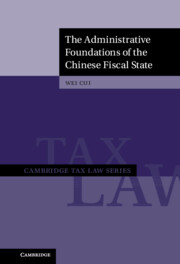Book contents
- The Administrative Foundations of the Chinese Fiscal State
- Cambridge Tax Law
- The Administrative Foundations of the Chinese Fiscal State
- Copyright page
- Dedication
- Contents
- Figures
- Tables
- Acknowledgments
- Abbreviations
- Introduction
- 1 The Forgotten Reform
- 2 What Is an Audit?
- 3 Atomistic Coercion
- 4 Returning Responsibilities to Taxpayers
- 5 Organizing Revenue
- 6 Policy Making without Information
- 7 The Rhetoric of Law
- 8 Varieties of State Capacity
- 9 Pivoting Away from the Rule of Law
- References
- Index
4 - Returning Responsibilities to Taxpayers
Published online by Cambridge University Press: 24 March 2022
- The Administrative Foundations of the Chinese Fiscal State
- Cambridge Tax Law
- The Administrative Foundations of the Chinese Fiscal State
- Copyright page
- Dedication
- Contents
- Figures
- Tables
- Acknowledgments
- Abbreviations
- Introduction
- 1 The Forgotten Reform
- 2 What Is an Audit?
- 3 Atomistic Coercion
- 4 Returning Responsibilities to Taxpayers
- 5 Organizing Revenue
- 6 Policy Making without Information
- 7 The Rhetoric of Law
- 8 Varieties of State Capacity
- 9 Pivoting Away from the Rule of Law
- References
- Index
Summary
Atomistic coercion generates an “equilibrium:” it would not make sense for any actor to change their behavior unless all actors change their behaviors at the same time. Chapter 4 demonstrate this with a recent, provincial tax administration reform. Echoing the 1997 tax administration reform agenda (which nationally had been abandoned), tax administrators in Jiangsu advocated “returning responsibilities to taxpayers,” i.e. enforcing the norm of truthful reporting. But reformers faced a predicament. Inaccurate information on tax returns makes it difficult to improve audits. The government’s capacity for observing most taxpayers could thus not hope in the short term to surpass that of revenue managers. But if direct personal monitoring of taxpayers declined because of reform, the government risked lowering compliance. The paramount objective of securing tax revenue pressures tax administrators to continue relying on traditional means of coercion, which undermines the government’s ability to threaten punishment for non-compliance beyond the traditional set of requirements. The objective of holding taxpayers accountable for truthful reporting thus remains elusive. Chapter 4 illustrates this dynamic through a novel dataset on the outcomes of a new type of audit function, “intermediate risk response,” that Jiangsu reformers instituted.
Keywords
- Type
- Chapter
- Information
- The Administrative Foundations of the Chinese Fiscal State , pp. 119 - 147Publisher: Cambridge University PressPrint publication year: 2022

